With fertiliser prices more than triple where they were this time last year in some cases and no sign of a significant drop anytime soon, it’s time to take action on farm to help to alleviate those high costs and reduce fertiliser needs.
There are some very simple steps that can be taken, while others may be more dramatic like planting multispecies swards.
Soil sample
The first thing that every farm should have to hand is an up-to-date set of soil samples, preferably taken within the past three years.
Soil pH should be the first thing to look at on these samples as it is the input that will most likely deliver the best return on investment.
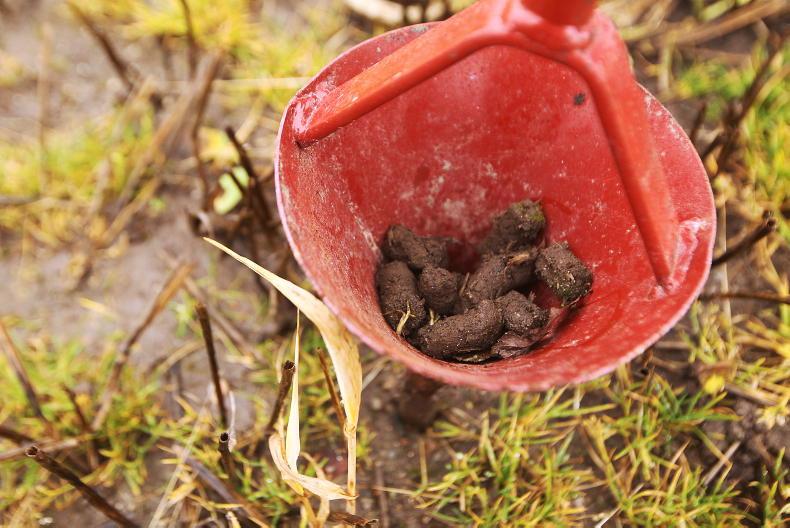
Soil testing.
Soil samples ensure that you are putting out the right amounts of fertiliser in the right areas. In a year where prices are high, you particularly want to make sure that you are not over-applying. If soils are at index 4 for potassium, for example, you might take a break from the nutrient and save on the spend.
Slurry and farmyard manure could then be targeted at areas low in P and K or on ground where they will deliver the most crucial yields.
Lime
Lime should be applied to soils low in soil pH. Low soil pH levels result in the inefficient use of nutrients, so the soil will not be working at its best to release nutrients from the soil and the fertiliser use efficiency can also deteriorate at low pH.

Spreading lime.
Grassland, cereals and maize need a soil pH of about 6.5, while beet, beans, peas and oilseeds look for a pH of 7 and potatoes are much lower at a soil pH of 6.
Make use of
organic manures
This year is the time to make the most of organic manures on your farm or available in your local area. Aside from slurry and farmyard manure on your own farm, see what’s available locally.
Testing these manures is important. Once the nutrient content is known, the value, the cost and the length of the draw can be considered.
Regular testing of slurry is important as it gives an accurate account of what is being applied.
Applying slurry using low-emission slurry spreading (LESS) equipment will result in less nitrogen being lost to the atmosphere.
Teagasc research shows that LESS equipment can result in 3 units of nitrogen/1,000 gallons of cattle slurry extra being made available.
So where a splashplate provides 6 units of N/1,000 gallons, LESS equipment can provide 9 units/1,000 gallons.
Protected urea
Protected urea reduces the loss of ammonia from urea fertiliser and therefore can increase the amount of nitrogen available to the growing plant. However, urea is proving difficult to source and is more expensive than standard urea, but reduced losses can result in reduced rates and the product is generally cheaper per kg of nitrogen than CAN.
Consider rotation
and forage crops
If you are considering reseeding on your farm, it might be an opportunity to plant a forage crop ahead of the new reseed. Early planting can allow kale to be planted.
Forage crops can be a really good option where silage or grass for grazing is short in the backend of the year as it extends the grazing season, especially for lighter animals as they will cope better if weather is wet.
Where silage yield isn’t meeting requirements, it may also be a good idea to contact your local tillage farmer about growing forage crops after winter cereals. When planted early, these crops have the potential to produce large amounts of biomass without artificial fertiliser. Options could include hybrid brassicas, forage rye and fast-growing grasses like Italian ryegrass.
However, it should always be taken into account that weather can make it difficult to graze these crops.
Clover and legumes
Clover and other leguminous crops like peas and beans take nitrogen from the air and fix it for use by crops.
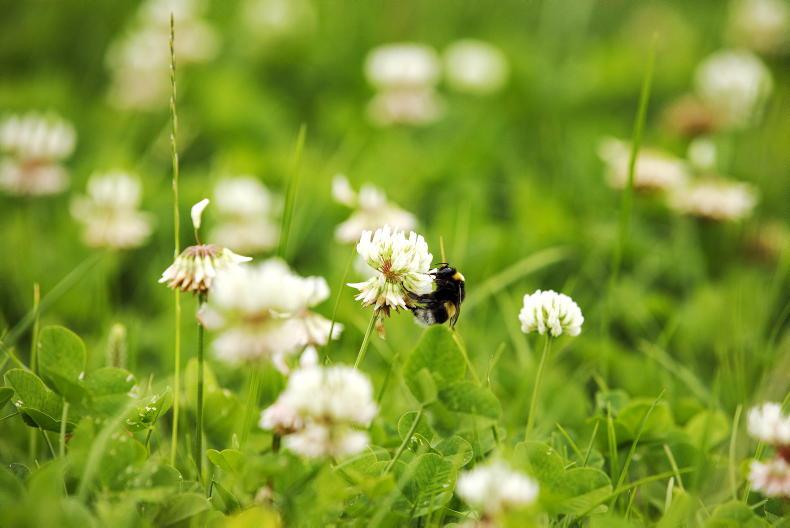
Clover. \ Donal O'Leary
How much clover have you in your grass swards? Teagasc research shows that nitrogen rate can be reduced from 250kg N/ha on a grass-only swards to 150kg N/ha on grass and clover swards where clover content is at 20%.
Clover content can decrease in swards where nitrogen is being applied at high rates. Cutting back on artificial nitrogen fertiliser use can help to increase clover in swards as the clover has more work to do.
Stitching in, using clover-safe sprays and including clover in a reseed can all help to reduce N application rates.
Peas and beans do not require any artificial nitrogen. However, tillage farmers should remember that the area planted to these crops is likely to increase and the payment is likely to reduce as a result.
Multispecies swards
Multispecies swards generally contain a high percentage of legumes like clover (maximum 40% to avoid leaching of N). Many multispecies swards just require a low rate of urea in spring and once soils heat up the clover can supply the nitrogen.
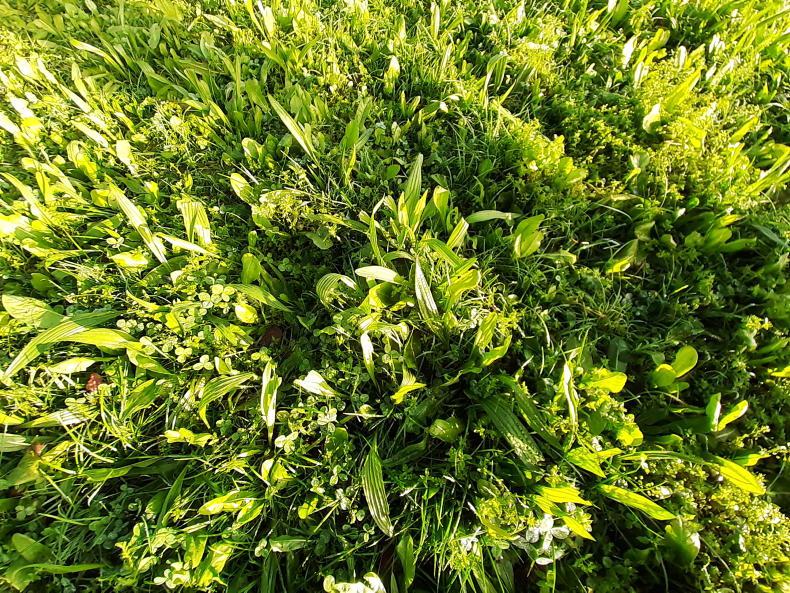
A multispecies sward.
The different rooting depths of plants in multispecies swards can also help to take nutrients from more resources and can help to improve soil structure to cope better at times of drought and to combat compaction.

With fertiliser prices more than triple where they were this time last year in some cases and no sign of a significant drop anytime soon, it’s time to take action on farm to help to alleviate those high costs and reduce fertiliser needs.
There are some very simple steps that can be taken, while others may be more dramatic like planting multispecies swards.
Soil sample
The first thing that every farm should have to hand is an up-to-date set of soil samples, preferably taken within the past three years.
Soil pH should be the first thing to look at on these samples as it is the input that will most likely deliver the best return on investment.

Soil testing.
Soil samples ensure that you are putting out the right amounts of fertiliser in the right areas. In a year where prices are high, you particularly want to make sure that you are not over-applying. If soils are at index 4 for potassium, for example, you might take a break from the nutrient and save on the spend.
Slurry and farmyard manure could then be targeted at areas low in P and K or on ground where they will deliver the most crucial yields.
Lime
Lime should be applied to soils low in soil pH. Low soil pH levels result in the inefficient use of nutrients, so the soil will not be working at its best to release nutrients from the soil and the fertiliser use efficiency can also deteriorate at low pH.

Spreading lime.
Grassland, cereals and maize need a soil pH of about 6.5, while beet, beans, peas and oilseeds look for a pH of 7 and potatoes are much lower at a soil pH of 6.
Make use of
organic manures
This year is the time to make the most of organic manures on your farm or available in your local area. Aside from slurry and farmyard manure on your own farm, see what’s available locally.
Testing these manures is important. Once the nutrient content is known, the value, the cost and the length of the draw can be considered.
Regular testing of slurry is important as it gives an accurate account of what is being applied.
Applying slurry using low-emission slurry spreading (LESS) equipment will result in less nitrogen being lost to the atmosphere.
Teagasc research shows that LESS equipment can result in 3 units of nitrogen/1,000 gallons of cattle slurry extra being made available.
So where a splashplate provides 6 units of N/1,000 gallons, LESS equipment can provide 9 units/1,000 gallons.
Protected urea
Protected urea reduces the loss of ammonia from urea fertiliser and therefore can increase the amount of nitrogen available to the growing plant. However, urea is proving difficult to source and is more expensive than standard urea, but reduced losses can result in reduced rates and the product is generally cheaper per kg of nitrogen than CAN.
Consider rotation
and forage crops
If you are considering reseeding on your farm, it might be an opportunity to plant a forage crop ahead of the new reseed. Early planting can allow kale to be planted.
Forage crops can be a really good option where silage or grass for grazing is short in the backend of the year as it extends the grazing season, especially for lighter animals as they will cope better if weather is wet.
Where silage yield isn’t meeting requirements, it may also be a good idea to contact your local tillage farmer about growing forage crops after winter cereals. When planted early, these crops have the potential to produce large amounts of biomass without artificial fertiliser. Options could include hybrid brassicas, forage rye and fast-growing grasses like Italian ryegrass.
However, it should always be taken into account that weather can make it difficult to graze these crops.
Clover and legumes
Clover and other leguminous crops like peas and beans take nitrogen from the air and fix it for use by crops.

Clover. \ Donal O'Leary
How much clover have you in your grass swards? Teagasc research shows that nitrogen rate can be reduced from 250kg N/ha on a grass-only swards to 150kg N/ha on grass and clover swards where clover content is at 20%.
Clover content can decrease in swards where nitrogen is being applied at high rates. Cutting back on artificial nitrogen fertiliser use can help to increase clover in swards as the clover has more work to do.
Stitching in, using clover-safe sprays and including clover in a reseed can all help to reduce N application rates.
Peas and beans do not require any artificial nitrogen. However, tillage farmers should remember that the area planted to these crops is likely to increase and the payment is likely to reduce as a result.
Multispecies swards
Multispecies swards generally contain a high percentage of legumes like clover (maximum 40% to avoid leaching of N). Many multispecies swards just require a low rate of urea in spring and once soils heat up the clover can supply the nitrogen.

A multispecies sward.
The different rooting depths of plants in multispecies swards can also help to take nutrients from more resources and can help to improve soil structure to cope better at times of drought and to combat compaction.










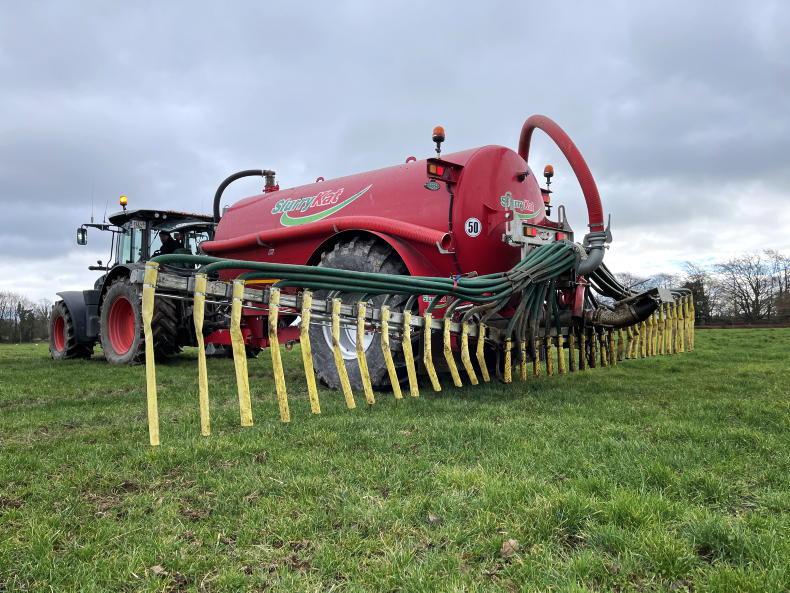



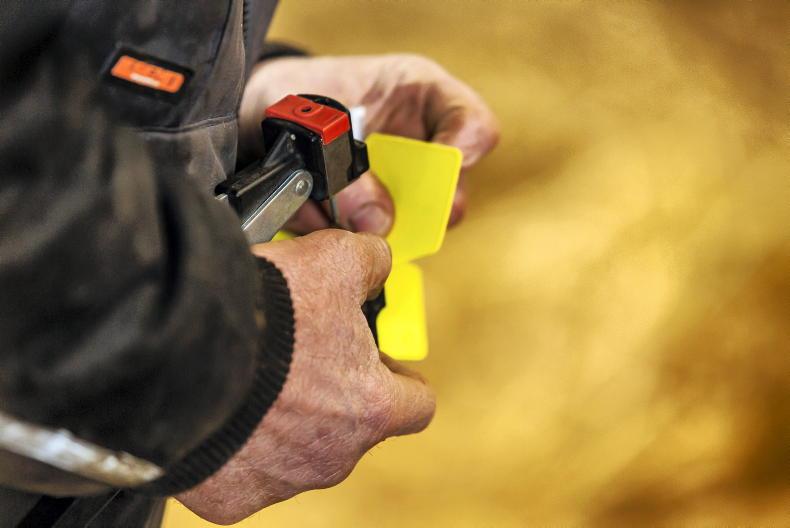

SHARING OPTIONS